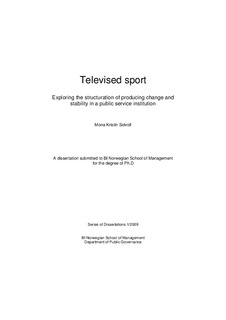Televised sport: Exploring the structuration of producing change and stability in a public service institution
Abstract
This thesis has both an empirical and a theoretical ambition. First, the empirical concern is uncovering the processes that shaped and influenced the production of televised football in the Norwegian Public Service Broadcaster, NRK from 1960 to 1995. Secondly, I hope to provide some insight into the theoretical debate on how organisational change and stability act together.
If we accept the assumption that organisations are pursuing change and, at the same time, promoting stability, we need to seek a theoretical context that embrace how an organisation undergoes renewal while retaining much of its institutional inertia at the same time. Drawing on Giddens’ structuration theory (1984), the thesis investigates how structures (rules and resources) provide temporal stability that enable agents to change them. In structuration theory, the structural principles are the most abstract elements of structures while the structural properties are the most concrete. My main concern has been how structures are instantiated in practice and how practices constitute structures. The term instantiation refers to the capacity of human actors to produce a more concrete realisation of some abstract structural principles, while constitution refers to a feedback device from larger concrete structural properties of practice to abstraction.
Empirically, the thesis illustrates how various aspects of public service broadcasting interact. It suggests an understanding of the “conceptual glue” which constructs and reproduces public service broadcasting as (1) a daily professional practice of producing and delivering program output, as (2) a policy organised within an institution, and (3) as an institution with a cultural ideology underpinning both programme making practices and the organising of a public service broadcaster.
Series
Series of Dissertations01/2009
